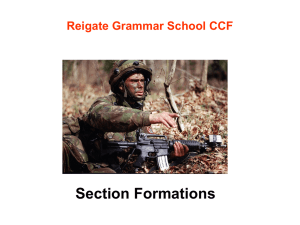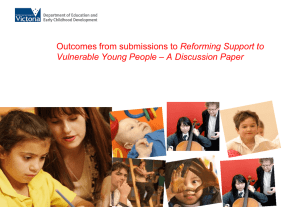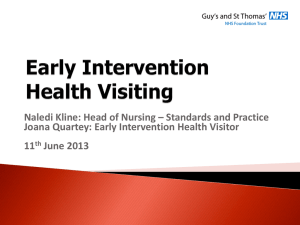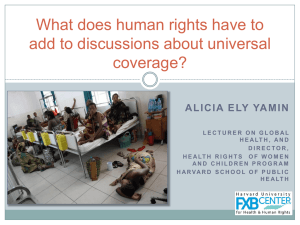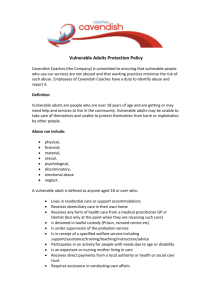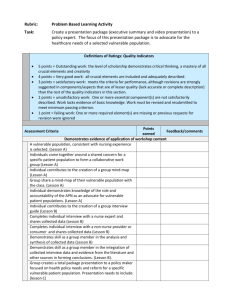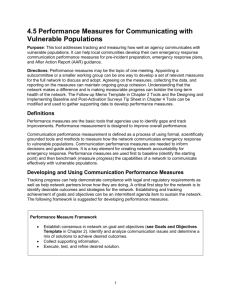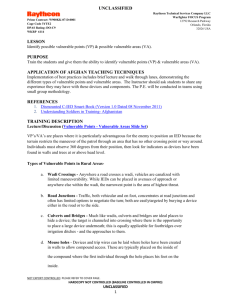The 29 Hazards 1. Damp & Mould Growth
advertisement
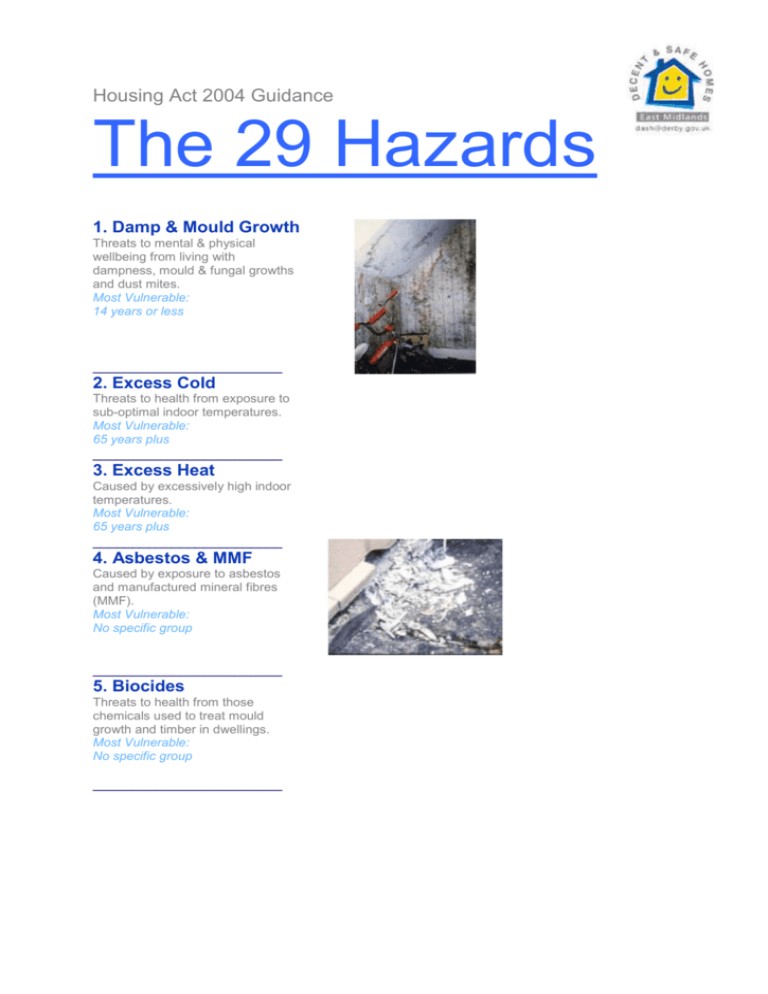
Housing Act 2004 Guidance The 29 Hazards 1. Damp & Mould Growth Threats to mental & physical wellbeing from living with dampness, mould & fungal growths and dust mites. Most Vulnerable: 14 years or less ________________________ 2. Excess Cold Threats to health from exposure to sub-optimal indoor temperatures. Most Vulnerable: 65 years plus ________________________ 3. Excess Heat Caused by excessively high indoor temperatures. Most Vulnerable: 65 years plus ________________________ 4. Asbestos & MMF Caused by exposure to asbestos and manufactured mineral fibres (MMF). Most Vulnerable: No specific group ________________________ 5. Biocides Threats to health from those chemicals used to treat mould growth and timber in dwellings. Most Vulnerable: No specific group ________________________ 6. Carbon Monoxide & Fuel Combustion Products Hazards due to high levels of CO, NO2, SO2 & smoke in the atmosphere. Most Vulnerable: For CO - 65 years plus, for NO2, SO2 & smoke – no specific group ________________________ 7. Lead Threats to health from the ingestion of lead. Most Vulnerable: Under 3 years ________________________ 8. Radiation Threats to health from radon gas, airborne, or dissolved in water. E.g., leakage from microwaves might be considered. Most Vulnerable: People aged 60-64 who have had a lifetime exposure to radon ________________________ 9. Uncombusted Fuel Gas The threat of asphyxiation due to fuel gas escaping into the atmosphere within a dwelling. Most Vulnerable: No specific group ________________________ 10. Volatile Organic Compounds VOC’s are diverse group of organic chemicals which includes formaldehyde that are gaseous at room temperature, and are found in a variety of materials within the home. Most Vulnerable: No specific group ________________________ 11. Crowding and Space Health hazards linked to a lack of living space for sleeping and a normal family/household life. Most Vulnerable: No specific group ________________________ 12. Entry by Intruders Problems keeping a dwelling secure against unauthorised entry, and the maintenance of defensible space. Most Vulnerable: No specific group ________________________ 13. Lighting Threats to physical and mental health linked to inadequate natural and/or artificial light. It includes the psychological effect associated with the view from the dwelling through glazing. Most Vulnerable: No specific group ________________________ 14. Noise Threats to physical and mental health caused by noise exposure inside the dwelling or within its cartilage. Most Vulnerable: No specific group ________________________ 15. Domestic Hygiene, Pests & Refuse Health hazards due to poor design, layout and construction to the point where the dwelling cannot readily be kept clean and hygienic; access into and harbourage within dwelling for pests; inadequate and unhygienic provision for storing and disposal of household waste. Most Vulnerable: No specific group ________________________ 16. Food Safety Threats of infection due to inadequate facilities for the storage, preparation and cooking of food. Most Vulnerable: No specific group ___________________ 17. Personal Hygiene, Sanitation & Drainage Threats of infection and threats to mental health associated with personal hygiene, including personal washing and clothes washing facilities, sanitation and drainage. Most Vulnerable: Under 5 years ___________________ 18. Water Supply for Domestic Purposes The quality and adequacy of the water supply for drinking and for domestic purposes such as cooking, washing, cleaning and sanitation. Most Vulnerable: No specific group ___________________ 19. Falls Associated with Baths etc. Falls associated with a bath, shower or similar facility. Most Vulnerable: 60 years plus ___________________ 20. Falls on the Level Falls on any level surface such as floors, yards and paths. It also includes falls associated with trip steps, thresholds or ramps, where the change in level is less than 300mm. Most Vulnerable: 60 years plus ___________________ 21. Falls Associated with Stairs and Steps Falls associated with stairs, steps and ramps where the change in level is greater than 300mm. It includes falls on stairs or internal ramps within the dwelling, internal common stairs or ramps within a building, access to the dwelling and to shared facilities or means of escape in case of fire. It also includes falls over stair, step or ramp guarding (balustrading). Most Vulnerable: 60 years plus ___________________ 22. Falls between Levels Falls from one level to another, inside or outside a dwelling, where the difference in levels is more than 300mm. For example, falls out of windows, falls from balconies or landings, falls from accessible roofs, into basement wells, and over garden retaining walls. Most Vulnerable: Under 5 years ___________________ 23. Electrical Hazards Hazards from electric shock or electricity burns, including from lightning strikes. Most Vulnerable: Under 5 years ___________________ 24. Fire Threats from uncontrolled fire and smoke. It includes injuries from clothing catching alight, which appears to be common when people attempt to put out a fire. It does not include clothing catching alight from a controlled fire by reaching across a gas flame or an open fire used for space heating. Most Vulnerable: 60 years plus ___________________ 25. Hot Surfaces & Materials Burns or injuries caused by contact with a hot flame or fire, and contact with hot objects or hot non-water based liquids, and scalds – injuries caused by contact with hot liquids and vapours. It includes burns caused by clothing catching alight from a controlled fire or flame. Most Vulnerable: Under 5 years ___________________ 26. Collision & Entrapment This includes risks of physical injury from: Trapping body parts in architectural features, e.g. trapping limbs or fingers in doors / windows; Colliding with objects e.g. glazing, windows, doors, low ceilings and walls. Most Vulnerable: Under 5 years ___________________ 27. Explosions Threat from the blast of an explosion, from debris generated by the blast, and from the partial or total collapse of a building as the result of an explosion. Most Vulnerable: No specific group ___________________________ 28. Position & Operability of Amenities Threats of physical strain associated with functional space and other features at dwellings. Most Vulnerable: 60 years plus ___________________________ 29. Structural Collapse & Falling Elements The threat of the dwelling collapsing, or a part of the fabric falling because of inadequate fixing or disrepair, or as a result of adverse weather conditions. Structural failure may occur internally or externally. Most Vulnerable: No specific group __________________ A Summary of Landlord Responsibilities • Maintain exterior of dwelling and all structural elements • Maintain interior facilities that are part of the dwelling • Provide all equipment necessary to supply the utilities safely and correctly • Ensure all bathroom facilities are correctly installed and properly maintained • Maintain all drains, waste pipes, rainwater goods, inlet gullies and inspection chambers • Provide a hygienic kitchen environment including sinks, draining boards, worktops, cooking facilities, cupboards, shelves, and food storage facilities • Maintain air bricks, trickle vents, opening lights to windows and mechanical and nonmechanical ventilation equipment • Regularly maintain central heating and hot water systems 6409.

